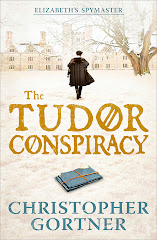I'm delighted to welcome Gordon Doherty, author of LEGIONARY: VIPER OF THE NORTH. Set during the Gothic Wars of the Roman Empire, this is an exciting and dramatic account of an unexplored time in history. Gordon is praised in his native United Kingdom for his painstaking research and stirring prose.
Please join me in welcoming him today as he shares this guest post explaining the background and genesis of his work:
 The Gothic crossing of the Danube in 376AD is considered a
defining moment in history, one that threw the Eastern Roman Empire into
turmoil and possibly led to the fall its western counterpart. Some suggest
that, in a matter of days, up to one million Goths spilled across the river and
into the empire while others estimate more conservatively at around one hundred
thousand. Even at the lower end of the
scale, and despite the Goths entering the empire in truce, such a monumental
population shift could only ever lead to one thing: War.
The Gothic crossing of the Danube in 376AD is considered a
defining moment in history, one that threw the Eastern Roman Empire into
turmoil and possibly led to the fall its western counterpart. Some suggest
that, in a matter of days, up to one million Goths spilled across the river and
into the empire while others estimate more conservatively at around one hundred
thousand. Even at the lower end of the
scale, and despite the Goths entering the empire in truce, such a monumental
population shift could only ever lead to one thing: War.
Yet, for many hundreds of years prior to the crossings, the
Germanic peoples inhabiting the lands immediately outwith the empire had never
come together so markedly – in-fighting , tribal pride and Roman subterfuge
ensuring they remained politically and militarily fractured. So what provoked
the Goths to cross the great river in 376 AD with such unprecedented unity and
conviction?
The answer lies far to the east, on the craggy and windswept
steppes near modern-day Mongolia. This was the land of a people we have come to
know as the Huns. At some point, probably in the 1st century AD, these hardy,
nomadic horsemen began an inexorable migration westwards. Some believe they were
driven from the east by aggression from the Han Chinese or by a confederation
of rival nomadic peoples. Whatever their stimulus, the Huns seemed set on
chasing the setting sun, sending entire peoples into flight as they moved west.
This triggered what historians now describe as ‘The Great Migration’, a
momentous gravitation of population from the east towards Europe. The Huns’
mastery of archery and mounted warfare saw them subjugate almost every tribe
they came across in the steppes and then Scythia. The Roman historian, Ammianus
Marcellinus, tells how peoples such as the Alani, the Agathyrsi, the
Anthropophagi, the Budini, the Geloni, the Melanchaenae and the Neuri all fell
under the Hunnic yoke. These tribes were then pressed into service for the
Hunnic advance on the next westerly target: Gutthiuda, land of the Goths and
the last buffer between the Huns and the Roman Empire.
In late 376 AD, the Gothic armies were fractured, with many
rival ‘Judges’ competing for ultimate power. But when the Huns appeared
en-masse on their northern borders, these squabbling warlords at last set aside
their differences, with Fritigern emerging as their leader. But, caught
unawares by such a ferocious army of invaders, the unified Goths quickly
realised that they could not stand their ground and fight. So, like every other
people who had found themselves in the Huns’ path, the Goths fled for their
lives; to the south, to the Danube and to the Eastern Empire. The border
legions garrisoning the forts along the River Danube were under-strength,
poorly equipped and ill-prepared for any major border activity. Added to that,
they found themselves as the guardians of Thracia and Moesia after Emperor
Valens had summoned the bulk of the field armies of those provinces to the
Persian frontier.
So when Fritigern and a sea of Gothic warriors and families
appeared on the northern banks of the Danube appealing for sanctuary, the
legions had no option but to allow them entry. Ammianus, writing some years
after the event, describes the subsequent Gothic crossing of the Danube as
fervent and troubled;
 ‘The crowd was such
that, though the river is the most dangerous in the world . . . a large number
tried to swim and were drowned in their struggle against the force of the
stream.’
‘The crowd was such
that, though the river is the most dangerous in the world . . . a large number
tried to swim and were drowned in their struggle against the force of the
stream.’
Emperor Valens is thought to have applied some retrospective
spin to this tumultuous event, lauding the Goths as ready-made reinforcements
for the patchy border legions. In reality, however, it was the first of many
dark days for the empire. Famine soon gripped the overpopulated refugee camp
and the surrounding Roman settlements. This, combined with a succession of
Roman atrocities – including beatings, murders and the selling of Gothic
children into slavery in exchange for rotting dog meat – set Fritigern and his
people on the march to Marcianople in search of food. Then, at the gates of the
city, he was the subject of a bungled assassination attempt by the local Roman
commander. With that, the last vestige of Roman-Gothic truce evaporated, and
Fritigern rallied his armies to strike back. The Gothic War had begun. What followed would push the
Eastern Empire to its breaking point.
The ‘Legionary’ series is set in the Eastern Roman Empire,
and follows the adventures of the impoverished border legions stretched across
the Danube frontier in these troubled years.
‘Legionary: Viper of the North’ is the second volume in the series and
picks up where the first left off, taking the reader right down to the front
ranks and into the eye of the storm, weaving a tale around the Gothic crossings
and the chaos that ensued.












2 comments:
I am just finishing up "Kincaid and the Legal Massacre" by Curtis D. Carney an adventurous historical fiction. As soon as I have finished reading it, I am going out to find your book. Thank you for suggesting it! Looks amazing!
http://www.insightpressbooks.com/
Sounds good! I'm neck deep in Roman history right now doing research for a book. I find it really interesting that in the last few years Roman history has really gotten it's place in fiction whereas before it wasn't all that easy to find. I'll have to add your book to my ongoing to-read list ;)
Post a Comment